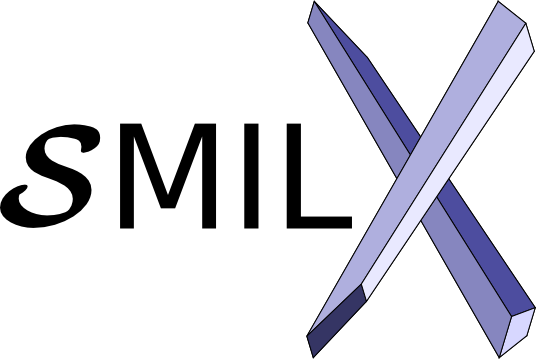 sMILX
Help
sMILX
Help
Imaging
This page describes the image
processing capabilities of sMILX. A image in sMILX is
defined as a set of voxels/pixels arranged as a rectangular volume that
has an origin, spacing of each axis and orientation of the volume. An
important consideration of the image window is that the original volume
is maintained as an ITK image. All processing is applied to the ITK
image unless otherwise stated. This is to ensure stability and
correctness of the processing as much as possible. Visualisation is
done directly with VTK.
There are a few batch operations available in the Image menu, where the
images are processed by the order in which they were opened:
- Add Images - Sum all (open, unminimised) images in the current
tab together to create a single summation image.
- Average Images - Sum all (open, unminimised) images in the
current tab together and divide by the number of these images to create
a single average image.
- Difference Images - Subtract all (open, unminimised) images from
the first opened image and create a single difference image.
- Convolve Images - Convolve all (open, unminimised) images to the
first opened image and create a single convolution image.
Note: The above also applies to
vector images if ITK 4 was used to build
sMILX. Convolution is done in nlogn complexity, if ITK 4 was
used to build sMILX.
The remaining options are mostly available through the right click menu
and are described below:
- Compare - Click on this for every image that your want to show
the ckecboard for or to overlay together. (Work in Progress)
- Link Windows - Link all the windows so that the camera of the
view is always oriented exactly the same in real space in all windows
of the tab.
- Switch to - Switch to window given in the open windows list.
- Import
View from - Import the 'actors' (i.e. the display elements, such as the
slice or surface or field) to this current display. This can be used
for overlaying surfaces on slices etc. Note that the imported actor
will be 'in front' of the current actors, useful to know when the
actors exactly overlap and one cannot be seen, i.e. the order makes a
difference when the objects are in exactly the same space.
- Operations - process the voxel/pixel values of the image:
- Rescale Inensities - rescale the pixel values to a new provided
range.
- Smooth (Anisotropic Diffusion) - Smooth the voxels using the
Gradient Anistropic Diffusion (parameters in log window).
- Smooth (Gaussian Convolution) - Gaussian blur the image.
- Smooth (Median) - Median filter the image.
- Gradient Magnitude - Show the edges within the image using the
Gradient magnitude of the image.
- Sobel Edges - Use the three Sobel edge convolution kernels to
show the edges in the image.
- Normalize - Statistically normalise the image to unit variance
and zero mean.
- Math Histogram to - match the histogram of the current image to
the one provided.
- Thresholds - Apply thresholds to the voxel values in various ways:
- Otsu Multiple Threshold - Use histgoram based method to label
the image in the number of labels + background provided.
- Transforms - Transform the image in vairous ways:
- Match Info to - match the origin, spacing and orientation of
the current image to the one provided.
- Resample - place the current image into the image that was
provided (as origin, spacing and orientation etc.). Uses B-spline
interpolator.
- Resample as Labelled Image - same as 'Resample' but with the
nearest neighbour interpolator.
- Mask Image - mask the image with the mask image provided.
- Mask and Crop Image - mask the image with the mask image
provided then crop to the bounds of the mask as well.
- Display as Volume Rendering - show the image as a volume plot
using ray-casting
- Display Slice as Surface Plot - show the slice voxel values as a
surface plot. The height of the plot is the voxel values.
- Display Iso-surface - Create a iso-contour of the image voxels
and show it as a polygonal surface (generates a model window).
- Image Information - output the origin, spcaing etc. of the image
to the log window.
- Interpolation - Interpolate the image display
- Orientation - Apply the orientation as a transform matrix to the
image volume
- Contouring - (Work in Progress).
 sMILX
Help
sMILX
Help sMILX
Help
sMILX
Help